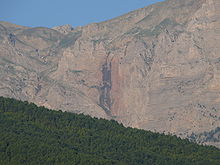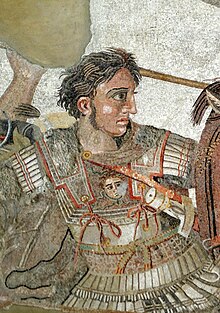Styx (Greece)
The Styx , in modern Greek Styga (Στύγα), now also called Mavronéri (Greek: black water), is an irregularly flowing, only a few hundred meters long river near Peristéra in the Aroania mountain range or Chelmos in Achaia in the north of the Peloponnese in Greece. It is a source river of the Krathis . Based on Hesiod's description in the theogony, it is associated with the mythical river Styx .
geography
From the almost vertical south-eastern rock face of the mountain Neraidorachi or Neraidochori (2238 meters) in the Aroania Mountains (also called Chelmos ), the Styx waterfall plunges about 200 meters into a gorge. The foot of the waterfall is about 1,600 meters above sea level. Behind the waterfall there is a small cave and a rubble ridge (scree slope) in which the water disappears and reappears as a mountain stream at the foot of the gorge. The waterfall only carries larger amounts of water at the end of winter and in spring. In summer, at best, a veil of water can be observed, which is dispersed by the wind because of the great height of fall. The waterfall is now called "Mavroneri" ("black water") by the locals . Coordinates: 37 ° 59 ′ 21 ″ N , 22 ° 12 ′ 28 ″ E
Legend and research
Legend attributes deadly properties to the water of the Styx. According to the Greek travel writer Pausanias in the 2nd century AD, goats that accidentally drank from it fell dead.
Among other things, Alexander the Great is said to be on June 10, 323 BC. Chr. In Babylon he died in agony after two weeks of a drink mixed with Styx water. For two days and nights he tried in vain to cure the nausea that initially appeared, still overwhelmed by grief over his deceased lover Hephaistion , with undiluted wine until he cried out of sleep with a high fever and sharp pain in the upper abdomen. Every touch of the skin triggered burning pain, as if the body were covered by open wounds. Afterwards the Macedonian was mentally confused, his rumbled commands remained incomprehensible to the escorts. After a week he could only move his head and fingers.
The toxicologist Antoinette Hayes, after joint research with the US historian Adrienne Mayor from Stanford University, attributes these symptoms to the primordial bacterium Micromonospora echinospora , which could have multiplied en masse in the rubble. Because the bacterium that grows on limestone needs a lot of oxygen in addition to ammonia from the rainwater and calcium and magnesium chloride dissolved from the rock in order to multiply in the absence of light, as it could have been supplied by the atomization in the shaft. The microorganism produces the deadly cell toxin calicheamicin .
The enediyne break Hayes According to the DNA. After the genetic damage, lifeless cell clumps remained, whereby even very small doses can lead to extensive apoptosis . Therefore, once poisoned, the organism can only recover with difficulty. An antidote is still unknown today. The first signs such as weakness and tiredness were followed by more and more parts of the body. In the final stage, the liver, kidneys, bladder, lungs, heart and nervous system failed in quick succession.
Mild oral poisoning can lead to temporary loss of voice. This corresponds to the fact that according to the Greek legend Zeus committed the gods to sacred oaths on the banks of the mythological Styx . If they lied, God the Father forced them to drink the river water, which deprived them of all speech and movement for almost a year.
If Alexander had died of the poison, which was "hallowed" in this way, it would make sense to look for the murderer of the commander, who was aloof from himself and a demigod, among his Greek companions, to whom he had given empty promises to return home soon. In any case, the theory of Alexander's death by Styxwasser is unproven and is doubted by many historians.
According to legend, Achilles is said to have received his invulnerability after a bath in the waters of the Styx.
Individual evidence
- ^ Meyers Konversationslexikon and Robin Hard, Herbert Jennings Rose (eds.): The Routledge handbook of Greek mythology. based on HJ Rose's "Handbook of Greek mythology" . Routledge, London 2004, ISBN 0-415-18636-6 , p. 110.
- ↑ Spiegel-Online from August 6, 2010
- ↑ a b c Telegraph August 6, 2010
- ↑ Conditions for Protoplasting, Regenerating ... Micromonospora echinospora (PDF; 701 kB) by Susan F. Love, William M. Maiese and David Rothstein 1991


